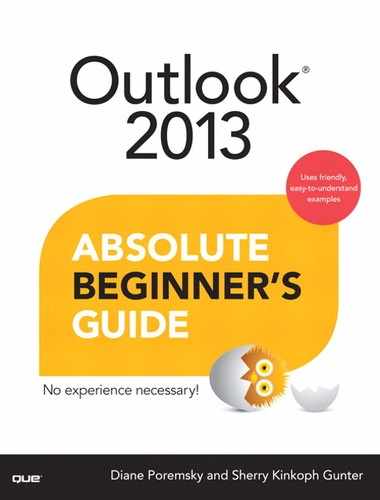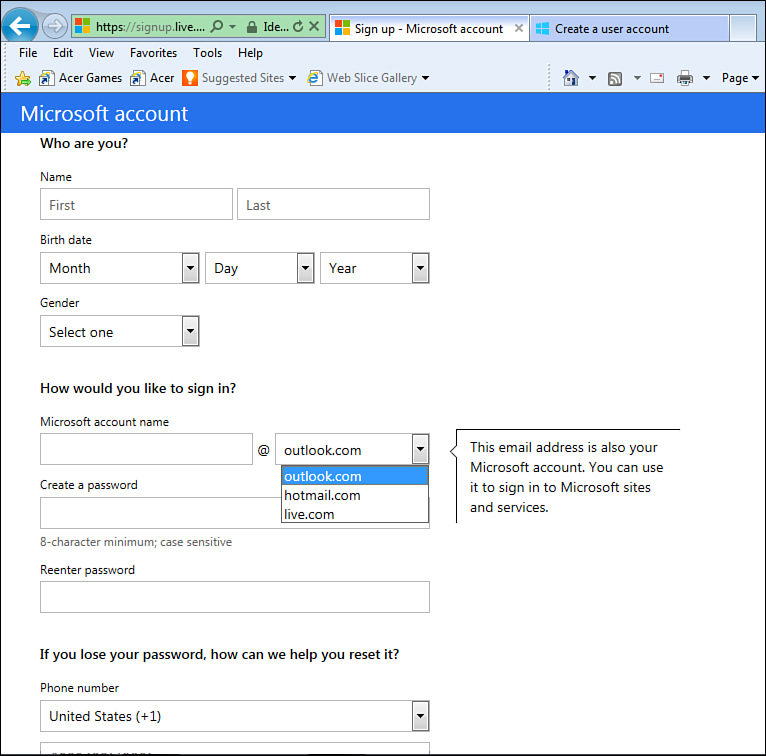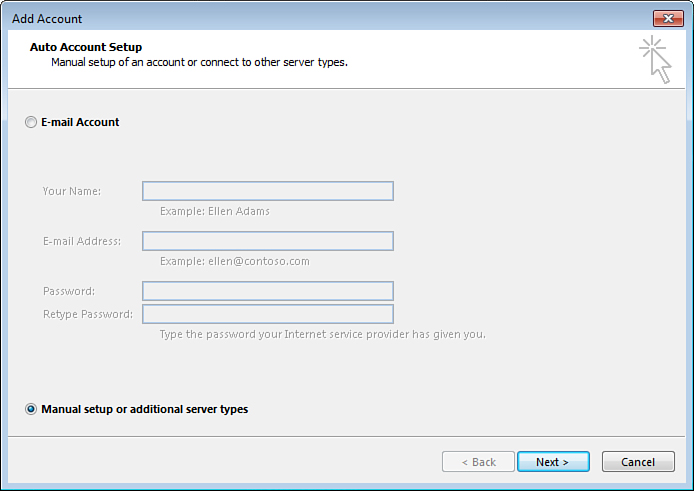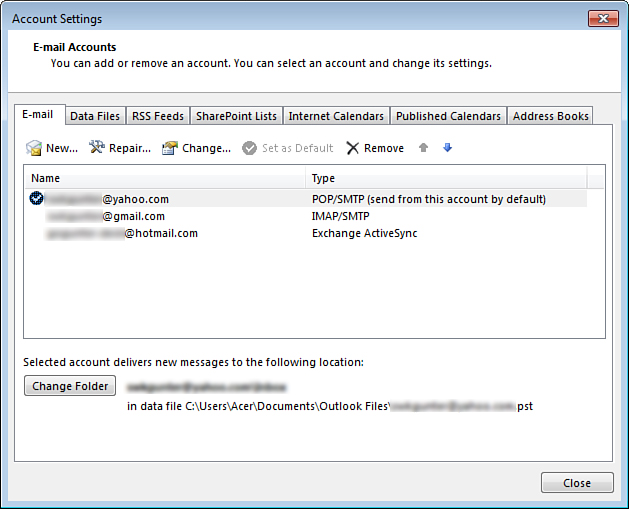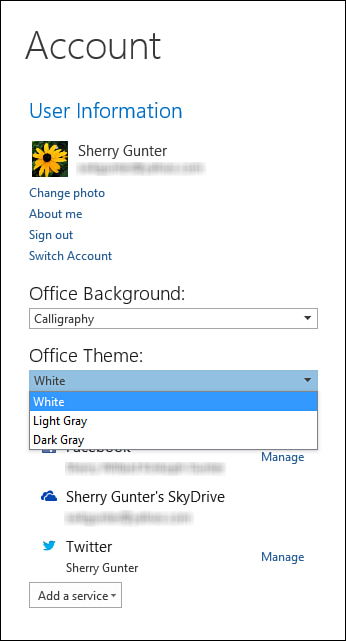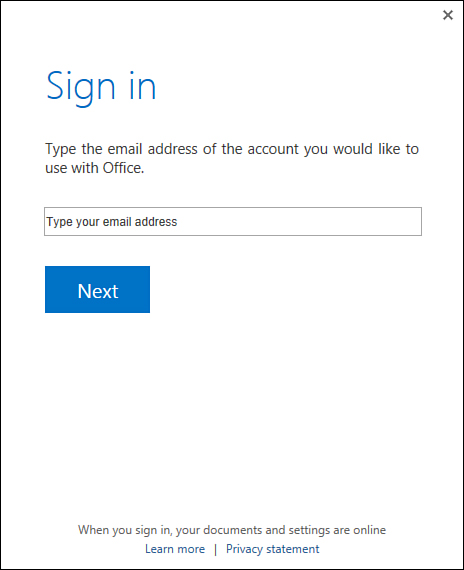3. Setting Up Accounts and Personalizing Outlook
In This Chapter
• Find out more than you wanted to know about types of email services
• Learn how to use Backstage view
• Add new email accounts and keep track of them with ease
• Change your user account’s background and account photo
• Switch between user accounts
Outlook’s Mail module is a serious workhorse, but before you can hook it up to the proverbial messaging plow, you need to make sure everything’s ready to go. By everything, I mean that all your email accounts need to be connected and configured. In this chapter, you learn how to add email services and make sure Outlook can play nicely with them.
Understanding Email Services and Internet Access
If you’re using Outlook at work, chances are Information Technology (IT) people or your network administrator set everything up for you. Lucky! If you’re using Outlook at home or you’re your own network administrator in a small office situation, you’re in charge of setting up Internet access and choosing email services. If you’re the boss of your own connectivity destiny, then like most people, you probably use an outside source to access the Internet. These typically include a cable, satellite, or phone company (home or wireless). Companies that offer Internet access through their giant servers and networks are called Internet service providers, or ISPs. In most instances, these types of connections encompass access to the Internet for web surfing as well as for email. Many offer dedicated storage on their servers, too, so you can back up important files. Email comes in several types of accounts:
• POP3—Post Office Protocol 3; this is the most popular email account type. With it, your email messages are downloaded from the server hosting your account and read and stored on your computer and not the mail server. This means you can read the messages on your computer only and the mail server keeps your email only until you download it (unless your provider has a Web mail interface).
• IMAP—Internet Message Access Protocol; this type of account stores your emails on the mail server without your needing to download them onto your computer. The nice thing about this setup is that you can access your messages from any computer.
• MAPI—Messaging Application Programming Interface; this account type is a lot like IMAP, but with more features, especially if you’re running Outlook with a mail server that uses Microsoft Exchange. MAPI accounts are generally associated with Microsoft Exchange.
• HTTP—This is a Web protocol, and you can use your browser to log on to the site and view mail. Yahoo! Mail, Hotmail, and Gmail are examples of Web-based email services.
 Note
Note
Microsoft Exchange is a server that handles email and collaboration tasks popular in business settings or larger organizations. More specifically, Exchange is a server program, and it’s designed to run on Windows Server products. In addition to email, it is a platform for calendaring and unified messaging, offering it a competitive advantage for businesses over standard POP3 setups. Microsoft Exchange also delivers a seamless Outlook experience across different devices. Exchange makes use of MAPI protocol, but it also supports POP3 and IMAP programs.
For a fee, ISPs offer the use of their equipment (giant servers and other computers and networks) and their connection to the Internet. Many include email as part of the package. Basically, this means you can set up an email address with them. On the downside, if you ever switch ISPs, you’ll have to switch email addresses and notify everyone of the change. If this potentially poses a problem, you might consider getting an email account through a free service.
Turns out Microsoft offers email, and all you need is a Microsoft account—it’s completely free. So, if you don’t already have an email service, it’s easy enough to set one up through Microsoft. Best of all, a Microsoft account works seamlessly with Outlook. Up until 2013, Microsoft’s free perks included email through their Windows Live and Hotmail services. Users needed a Windows Live ID to sign into things like SkyDrive (cloud storage), Messenger (the instant messaging service) or Windows Phone (smart phone). You had to have another ID to use Xbox Live to play games online. Now they’ve merged all these into one service under the umbrella called a Microsoft account. The good news is if you already have an account through Windows Live or Xbox Live, you already have a Microsoft account. They’re one and the same. You can use this account to access your data from any device, whether it’s your Xbox, Windows Phone, or tablet, for example. You can also connect your Microsoft account to services like Facebook, Twitter, and LinkedIn.
If you don’t have such an account yet, here is how to get one. Steer your web browser to www.outlook.com and click the Sign Up Now link, similar to Figure 3.1. You can then fill in a form and choose an email address, called a Microsoft account name. Figure 3.2 shows what the form looks like. You can even specify whether you want the new email account to use the outlook.com domain, hotmail.com, or live.com. Variety—it’s the spice of life.

FIGURE 3.1 You can sign up for a free Microsoft account on this page; look for the Sign Up link to get started.
Your account name can be anything you want. Most people use their actual names or a combination of initials and such to create a unique email address. If you happen to choose something already in use by someone else, Microsoft prompts you to try another name. After you’ve got a Microsoft account established, you can start using it to email with Outlook as long as you tell Outlook what the account is—learn more about adding and editing email accounts later in this chapter. I’ll even show you how to personalize your account with a profile picture. Yippee.
You can have all the free email accounts you want, but they don’t do you any good if you’re not connected to the Internet. To find an Internet service provider, check with your local cable or phone company. Cell phone companies also offer wireless connections you can use, such as setting up a hotspot in your house that all your household computing devices can access. It doesn’t hurt to shop around for the best deal, either. If you’re on the go all the time, you can also tap into free Wi-Fi services around town to surf the Internet and access your email accounts. (Wi-Fi stands for wireless fidelity, a technology that uses radio waves to provide high-speed Internet and network connections.) Just be sure to safeguard your computer when you do use Wi-Fi to prevent hacking (firewalls and virus protection, for example).
If you already have an email account, you’re good to go and can easily associate it with a Microsoft account. I’ll show you how in just a bit.
Using Backstage View
To start setting up Outlook to work the way you want, including adding email accounts or editing existing services and customizing Outlook, you need to visit Outlook’s Backstage view. It’s a weird name, I know, but this is what they call the screen that appears when you click the ribbon’s File tab. Figure 3.3 shows an example. Some of the items listed in this window vary ever so slightly based on which module you’re currently using, but the main elements stay the same. In fact, when you land in Backstage view (just click the File tab to get there), the Info page is displayed showing Account Information. You might as well familiarize yourself with Backstage view before you venture much further into Outlook. Any sort of changes to accounts or personalizing the program window are set in Backstage view.
The drop-down list at the top of the window reveals all the email accounts currently set up to work with Outlook. Click the drop-down arrow, shown in Figure 3.3, to reveal the accounts. Directly below this is a button you can use to add more email accounts to Outlook. A click of the Account Settings button, shown in Figure 3.4, reveals settings for changing account settings and social networks you connect to.
The list along the left side of Backstage view categorizes things you can set or features you can access, such as printing or exporting. Each category you select has its own settings to reveal. Click the Info category anytime you want to see the Account Information screen.
The navigation arrow in the top-left corner takes you back to whatever module you were viewing.
Now that you know how to find your way to Backstage view and what to expect when you get there, it’s time to fiddle with your accounts and program settings.
Adding Email Accounts to Outlook
You can use multiple email accounts with Outlook. This is extremely convenient. You might have a work account, for example, and a home account. Rather than having to check them separately, you can tell Outlook to work with both. Perhaps you have a special email account you use when signing up for online newsletters and advertising information. Or maybe each family member wants his or her own account. You can add additional accounts to Outlook and view your emails using the Mail module.
Outlook automatically configures your email accounts for you. All you need to specify is your email address and password; Outlook takes care of the rest. On the off chance it cannot establish a connection, you may need to gather up some additional information from your ISP and manually configure the account. This can include identifying your server type, the address of the incoming mail server and outgoing mail server, and any passwords required for each. We’ll go over both methods.
Automatically Configure an Account
To have Outlook automatically set up an email account, you need to switch over to Backstage view to get things started. Follow these steps:
1. Click the File tab.
2. Click Add Account.
3. The Add Account dialog box opens, as shown in Figure 3.5. Fill in your name in the first form field.
4. Type in the email address for the account you want to add.
5. Type in the account’s password.
6. Verify the password by typing it in again.
7. Click Next to continue.
8. Outlooks checks the network connection, finds your settings, logs on to the mail server, and then displays a congratulations prompt. Click Finish.
 Tip
Tip
You can also set up a new account through the Add Account dialog box. From Backstage view, click the Account Settings button, and then click the Account Settings command. This opens the dialog box listing all of your accounts. Click the New button to display the Add Account dialog box shown in Figure 3.6.
You can now see your new email account listed in the Folder pane in Outlook’s Mail module. When you click the Send/Receive All Folders button on the Home tab, Outlook checks the account for messages. Any messages received appear in the account’s Inbox; click the Inbox to view the messages. Remember, each account’s Inbox keeps a running list of messages received for that account.
 Note
Note
Uh-oh. Run into some snags? If you mistype any part of your email address or password, Outlook won’t be able to complete the automatic configuration. If you run into additional problems, you can try a manual setup, which is explained in the next section.
 Tip
Tip
One thing to consider when using multiple accounts is to make sure the correct account for new messages is selected before you send it off. If you’re trying to keep things organized and precise, you don’t want to send a business message from your personal account, for example.
Manually Configure an Account
The manual route might be right for you if you know your email provider has some preferred settings or if you decide you want to control the details about the setup. For example, you may need to ascertain a special Incoming mail server or outgoing mail server info, or special log on info. The first step in the manual process is to tell Outlook what type of email service you’re adding. You can choose from a Microsoft Exchange Server (an Exchange account), Outlook.com or Exchange ActiveSync service (use this option if you have a free email through Microsoft), or a POP or IMAP service. If you’re not sure, check with your email provider. They can provide you with all the pertinent info required.
After you’ve gathered all the correct information, you’re ready to set up an account. Depending on which type of email service you’re adding, different configuration steps appear. If you’re adding an Exchange account, Outlook prompts you to close Outlook and use Windows Mail settings in the Control Panel. If you’re adding an Outlook.com account, you must enter your server and logon information. If you’re adding a POP or IMAP account, you’ll need to specify the account type and the incoming and outgoing servers.
To start the process, click the File tab and click the Add Account button. So far, this is the same as having Outlook automatically configure the account. When the Add Account dialog box shows up, however, you need to click the Manual Setup or Additional Server Types option, as shown in Figure 3.7. Click the Next button to continue.
Now you’re presented with the Choose Service portion of the process, as shown in Figure 3.8. Select the type of email account you’re adding and click Next.
Depending on what you’re selecting, different options appear. Figure 3.9 shows the POP and IMAP Account Settings you need to fill in, and Figure 3.10 shows the Server Settings fields for an Exchange ActiveSync service.
 Tip
Tip
Click the More Settings button, if available, to add additional information.
After you’ve entered all the appropriate fields, you can click Next, and Outlook establishes the network connection.
Editing Your Email Accounts
You can make changes to your email accounts through the Account Settings dialog box. This particular box keeps a list of all the accounts you’re using. You can add new accounts from this dialog box, remove accounts you no longer use, or make changes to accounts. You can also reorder the way in which Outlook checks the accounts for new messages.
To access the dialog box, click the File tab to switch to Backstage view. Click the Add Accounts button, then click the Add Accounts command. A dialog box similar to Figure 3.11 appears, with the E-mail tab displayed.
From the Account Settings dialog box, you can do any of the following:
• To add a new account to the list, click the New button and follow the steps for automatically or manually configuring a new email service to work with Outlook.
• To repair an account, select it in the list and click the Repair button. This reopens the setup box containing the information about the account, which includes the same form fields you used to enter information about the email service; you can recheck the information.
• To change an account, select it in the list and click the Change button. This displays detailed information about the account, and you can make changes, such as setting a new password.
• To remove an account, select it and click the Remove button. Outlook warns you that you’re about to delete the account; click Yes and it’s gone.
• To change the default account—the account listed to send from in the new message window—click the account and click Set as Default.
• To change the order of your accounts, click the Up and Down arrows to move the selected account up or down in the list.
Personalizing Your User Account
You can do a little customizing to make Outlook your own, such as assigning an account picture and applying some design tweaks to the program window. The customizing settings you add apply only to your account. Other users who share Outlook with you can customize their own accounts.
Changing the Background and Theme
New to Outlook 2013, and the other programs in the Microsoft Office suite, is the capability to customize the program window background and theme. Changing the background only affects the very top of the program window (Title bar and ribbon tab names), but it does make you feel good choosing a design pattern that suits you. The design you choose does not spill over into the Information Viewer area, so it’s more of an extra visual element for personalizing Outlook.
To change the background, click the File tab and click Office Account to view the Account settings shown in Figure 3.12. Click the Office Background drop-down arrow, as shown in Figure 3.13. Move your mouse pointer over the different selections to preview what each one looks like. Click the one you like, and it’s immediately applied. To remove a background, just choose the No Background selection.
The Office theme is a choice between White, Light Gray, or Dark Gray, as shown in Figure 3.14. This color affects the top of the program window, too, including the ribbon.
To fully appreciate your new customizing options, click the Back navigation arrow (top-left corner) and return to the Outlook window. Now sit back and admire your tweaks.
Adding and Switching User Accounts
You can add multiple user accounts to Outlook and switch between them. User accounts are called Office accounts, and you can use them across all the Office suite of programs. This is helpful if you are sharing Outlook with other users in your household, for example. You can create an account for each family member and they can customize their accounts the way they like.
To add an account, start by displaying the Account page again (click the File tab and click Office Account). Click the Switch Account link to get things rolling; Outlook opens the Accounts box, shown in Figure 3.15. If you already know the other person’s email and password, you can set up the account, or the person can take over your keyboard and do it. Click Add Account to start the process by displaying the Sign In box, similar to Figure 3.16; you have to enter the email address, followed by the password. After the new account is created, it’s automatically added to the user Accounts list.
To switch between multiple accounts, click the Switch Account button on the Account page to display the Accounts box shown in Figure 3.15. Click the account you want to use in Outlook and you’re ready to go.
Changing Your Account Photo
The account photo is shown with all your Microsoft account activities online as well as in some of the Microsoft Office programs you use, such as Word and Excel. Surprisingly, the picture does not appear on your Outlook program window like it does in Word or Excel. However, it does appear in other users’ Outlook features when it comes to you as a contact or email recipient.
An account picture can be any graphic file found on your computer, including a photograph or an illustration. To assign a picture, click the Change photo link on the Account page (see Figure 3.12). This opens your online Microsoft account Profile web page, shown in Figure 3.17. (If you’re not logged on to your account, you can sign in first.) Click the Change Picture link.
From the Picture page, shown in Figure 3.18, click the Browse button. This opens the Choose File to Upload dialog box, as shown in Figure 3.19.
Navigate to the folder or drive containing the image you want to use, and select the image. Click Open to return to the Picture page (see Figure 3.20). Per the instructions there, you can drag or resize the picture box to get the best part of your picture to display as the account photo. When you have everything just right, click the Save button.
The Profile page now displays the new account picture, as shown in Figure 3.21. You can close out the browser window.
